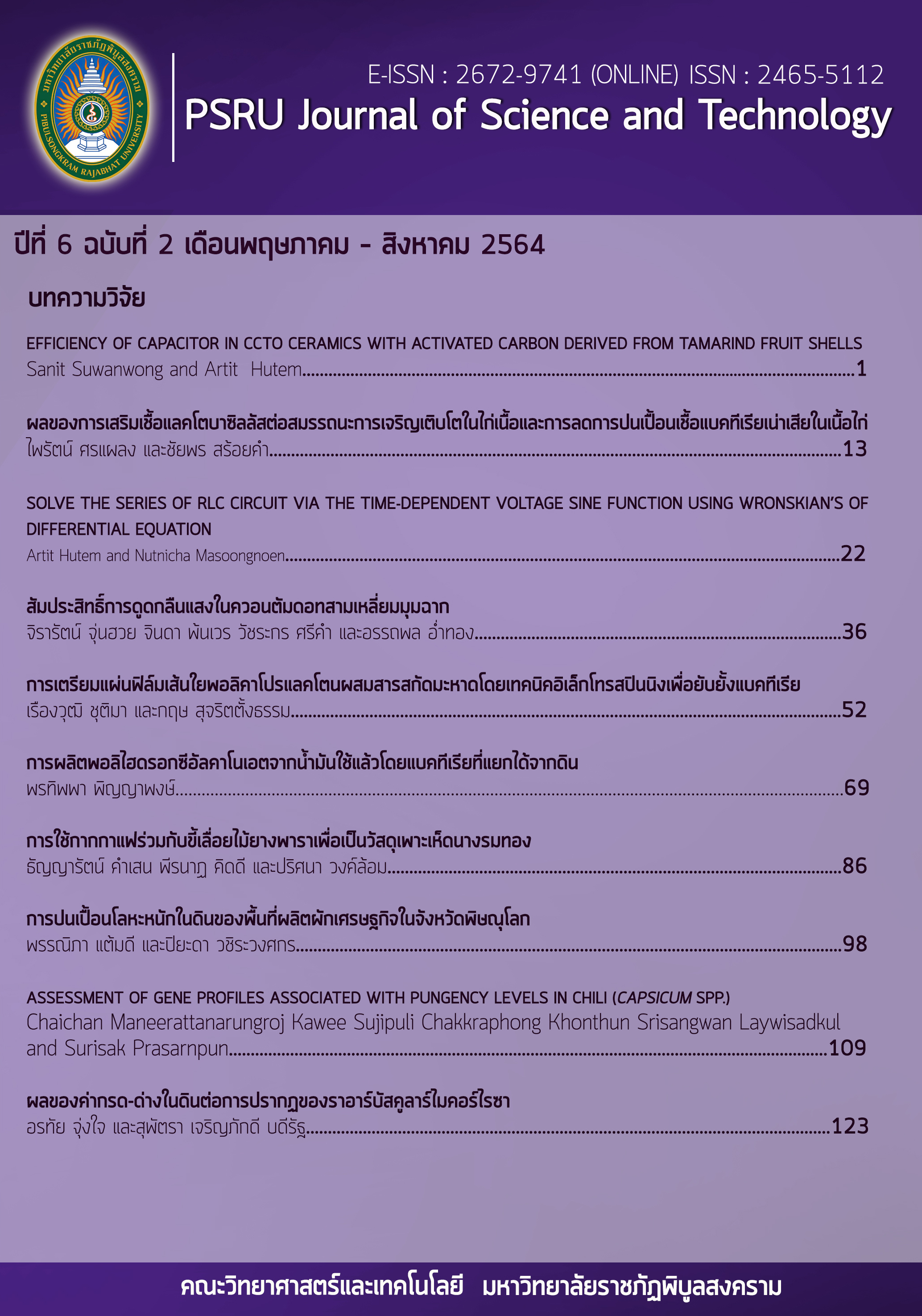USE OF COFFEE GROUND WASTE WITH RUBBER WOOD SAWDUST FOR GOLDEN OYSTER MUSHROOM (PLEUROTUS CITRINOPILEATUS SINGER) CULTIVATION MATERIAL
Keywords:
Golden oyster mushroom, Coffee ground waste, Sawdust, Cultivation materialAbstract
The study of using coffee ground waste with rubber wood sawdust for golden oyster mushroom (Pleurotus citrinopileatus Singer) cultivation material was examined.
The objectives of this research were to study the growth of gold oyster mushroom and to investigate biological efficiency (% B.E.) and protein of golden oyster mushroom. The experimental design of this research was a completely randomized design (CRD) with 6 treatments and 3 replicates per treatment. The experimental replacement of coffee ground waste with rubber wood sawdust ratios were 20%, 40%, 60%, 80% and 100% and using sawdust only as a control (0% replacement). The results found that the replacement of coffee ground waste with rubber wood sawdust ratio of 20% were the highest number of mushroom (60.42+0.46 unit) and 40% had the most width and wet weight of mushrooms as 5.14+0.02 cm. and 36.28+0.42 g, respectively at the statistically significant level of p<0.05. The comparison of % B.E. with the control found that the replacement of rubber wood sawdust ratio of 40% was the highest 42.68% at the statistically significant level of p<0.05. The results of protein of golden oyster mushroom which the replacement of rubber wood sawdust ratio of 60% and 40% were height 37.15+0.11 and 36.67+0.14 g/100 g at the statistically significant level of p<0.05. Thus, it can be concluded that coffee ground waste can instead of rubber wood sawdust for golden oyster mushroom cultivation.
References
ชมรมนักเพาะเห็ดประเทศไทย. (2552). คู่มือธุรกิจฟาร์มเพาะเห็ด. กรุงเทพฯ: เกษตรการพิมพ์.
ชาญยุทธ์ ภาณุทัต. (2551). เทคนิคการเพาะเห็ดฟาง. กรุงเทพฯ: กองส่งเสริมพืชสวน กรมส่งเสริมการเกษตร กระทรวงเกษตรและสหกรณ์.
ชำนาญ พิทักษ์ทอง. (2553). เห็ดเศรษฐกิจ. (พิมพ์ครั้งที่ 3). กรุงเทพฯ: เกษตรสยามบุ๊คส์.
ณัฐวรา กิจธรรมรัตน์, ภัทรพร เอี่ยมศิริกิจ, ศศธร ศิริกุลสถิตย์, บัวหลวง ฝ้ายเยื่อ และภัทรญา กลิ่นทอง. (2562). การพัฒนาวัสดุเพาะเห็ดนางรมทองจากกระดาษลัง และเปลือกผลไม้เพื่อเพิ่มฤทธิ์ต้านอนุมูลอิสระ. วารสารสิ่งแวดล้อม, 23(2), 1-9.
นันทินี ศรีจุมปา, และศิริกานต์ ขยันการ. (2554). การใช้วัสดุเหลือใช้ทางการเกษตรเพื่อผลิตเห็ด. วารสาร วิชาการเกษตร, 29(2),108-118.
บุษบา ล้อประเสริฐ. (2553). เห็ดหลินจือ. กรุงเทพฯ: เอเชียการพิมพ์.
ปริยานุช จุลกะ, พิจิตรา แก้วสอน, และปนัดดา จีนประสม. (2557). ผลของการใช้วัสดุปลูกที่มีส่วนผสมของกากกาแฟต่อการงอกและการเจริญเติบโตของต้นกล้ามะเขือเทศ. วารสารวิทยาศาสตร์เกษตร, 45(2 พิเศษ), 349-352.
วันทนา นาคีสินธ์. (2556). การใช้กากกาแฟทดแทนขี้เลื่อยในการเพาะเห็ดนางรมฮังการี. (วิทยานิพนธ์ปริญญามหาบัณฑิต). มหาวิทยาลัยศิลปากร, คณะวิทยาศาสตร์, สาขาวิชาวิทยาศาสตร์สิ่งแวดล้อม.
ศูนย์ลูกค้าสัมพันธ์ธุรกิจแฟรนไชส์. (2552). เซเว่น-อีเลฟเว่น. สืบค้น 22 กันยายน 2562, จาก http://www.smesreport.com/7-ELEVEN.
สุพัตรา เปี่ยมวารี, สรวิศ แจ่มจำรูญ, วันทนา สะสมทรัพย์, ธนภักษ์ อินยอด, และสุริวิภา สังขาร. (2554). การศึกษาคุณค่าทางโภชนาการของเห็ดนางฟ้าภูฎาน Pleurotus eous อบแห้ง. วารสารวิทยาศาสตร์เกษตร, 42(2 พิเศษ), 9-12.
สำนักงานกองทุนสนับสนุนการสร้างเสริมสุขภาพ. (2560). ปริมาณโปรตีนในอาหาร. สืบค้น 12 ตุลาคม 2562, จาก http://www.thaihealth.or.th.
อามีเนาะ อาแย. (2556). การใช้ประโยชน์ของภาชนะบรรจุกระดาษเหลือทิ้งในการเพาะเห็ดตระกูลนางรมที่มีสารต้านอนุมูลอิสระ. (วิทยานิพนธ์ปริญญามหาบัณฑิต). มหาวิทยาลัยสงขลานครินทร์, คณะการจัดการสิ่งแวดล้อม, สาขาวิชาการจัดการสิ่งแวดล้อม.
อุราภรณ์ สอาดสุด, วิชชา สอาดสุด, ธวัช ทะพิงค์แก, ศิริพร หัสสรังสี, นภาวรรณ โฆษิตเรืองชัย, อรอนงค์ อาร์คีโร, เพ็ญศิริ ศรีบุรี, และสุรพันธ์ กาญจนวงศ์. (2552). การควบคุมคุณภาพและยืดอายุหลังการเก็บเกี่ยวเห็ดสกุลนางรม (รายงานผลการวิจัย). เชียงใหม่: มหาวิทยาลัยเชียงใหม่.
Bessada, S.M.F., Barreira, J.C.M., & Oliveira, M.B.P.P. (2019). Pulses and food security: Dietary protein, digestibility, bioactive and functional properties, Trends in Food Science and Technology, 93, 53-68.
Khatun, S., Islam,A., Cakilcioglu, U., Perihan Guler, & Chatterjee, N. C. (2015). Nutritional qualities and antioxidant activity of three edible oyster mushrooms (Pleurotus spp.). NJAS - Wageningen Journal of Life Sciences, 72–73, 1–5.
Lin, S.Y., Chien S. C., Wang, S.Y., & Jeng-Leun M. (2015). Submerged cultivation of mycelium with high ergothioneine content from the culinary-medicinal golden oyster mushroom, Pleurotus citrinopileatus (Higher basidiomycetes). International Journal of Medicinal Mushrooms, 17(8), 749–761.
Musieba, F., Okoth, S., Mibey, R.K., Wanjiku, S., & Morra, K. (2012). Suitability of locally available substrates for cultivation of the Kenyan indigenous golden oyster mushroom (Pleurotus citrinopileatus Singer), American Journal of Food Technology, 7(10), 650-655.
Musieba, F., Okoth, S., Richard M., K., Wanjiku, & Knight M. (2013). Proximate composition, amino acids and vitamins profile of Pleurotus citrinopileatus Singer: An indigenous mushroom in Kenya. American Journal of Food Technology, 8, 200-206.
Pasakawee, K., Baniongsinsiri, P., Donrung, N., & Satiankomsorakrai, J. (2018). Nutritional and antioxidant properties of selected-commercial mushroom in Thailand. Journal of Food Science and Agricultural Technology, 4 (Spcl.Iss), 36-40.
Pujol, D., Liu C., Gominho, J., Olivella, M.À., Fiol, N., Villaescusa, I., & Pereira, H. (2013). The chemical composition of exhausted coffee waste. Industrial Crops and Products, 50, 423– 429.
Thiex, J.N., & Manson, H. (2002). New AOAC standard for crude protein determinations in animal feed, forage, grain and oilseed using tecatorkjeltec equipment. In Focus, 26(2), 10-12.
Thiex, J.N., Manson, H., Anderson, S., & Persson, J.(2002). Determination of crude protein in animal feed, forage, grain, and oilseeds by using block digestion with a copper catalyst and steam distillation into boric acid: Collaborative Study. Journal of AOAC International, 85(2), 309-317.
Downloads
Published
How to Cite
Issue
Section
License
กองบรรณาธิการขอสงวนสิทธิ์ในการปรับปรุงแก้ไขตัวอักษรและคำสะกดต่างๆ ที่ไม่ถูกต้อง และต้นฉบับที่ได้รับการตีพิมพ์ในวารสาร PSRU Journal of Science and Technology ถือเป็นกรรมสิทธิ์ของคณะวิทยาศาสตร์และเทคโนโลยี มหาวิทยาลัยราชภัฏพิบูลสงคราม และ
ผลการพิจารณาคัดเลือกบทความตีพิมพ์ในวารสารให้ถือมติของกองบรรณาธิการเป็นที่สิ้นสุด







